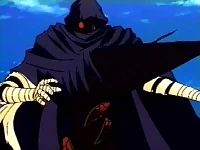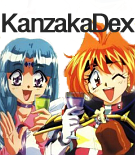
A fight between two mazoku: Seigram (left) and Xelloss in his beast form
A mazoku (Japanese: 魔族 Kanji translation: Evil Race or Demon Race; Romaji: mazoku; English: Monster (Software Sculptors)) is a genderless spiritual being that resides on the astral side.
Mazoku do not have a true physical form, but ones with enough power can project an image onto the physical plane to represent themselves. They also have a so-called beast form; a form that is closer, but mostly not equivalent to, their appearance in the astral side. They are the force opposite the shinzoku. Also referred to as creatures of chaos, the ultimate goal of their existence is to return the world in its original form - the Sea of Chaos, effectively destroying it in the process. It must be noted that regardless of her occurrent desires, the Lord of Nightmares is not a mazoku, although even high ranking shinzoku and mazoku are known to believe otherwise.
Mazoku can be divided into four ranks, according to the amount of power they possess: high-ranking, middle-ranking, low-ranking mazoku and lastly the lesser demons.
Mazoku are not born or spawned by sexual reproduction. When a mazoku decides to reproduce, it basically chops off a chunk of its astral body, essentially itself, and that becomes a new, weaker mazoku. The amount of power the newly created mazoku possesses depends on the amount of power its creator sacrificed in order to create it; the creator basically gives up some of its own might and passes it to its new underling. Although a mazoku can gain power by itself by consuming sufficient amounts of shōki (see below), that is a very slow process. Therefore, creating high-ranking mazoku is something that can only be done by ma-ō or subordinates of a ma-ō, and even then, rarely can it be done. (Hellmaster Fibrizo's priest and general, for instance, died in the Kōma War, but he did not create new ones.)
A mazoku's source of energy (food) is shōki, the miasma produced by humans and other beings (even manifested lesser demons) when they experience negative emotions such as anger, sadness, and fear. Mazoku can sense malice and enmity in humans, and are able to use those sentiments like homing devices when need be.[1] Being able to appear as a human is a great adaptation for a mazoku, as it allows it to live among humans and feed off their emotions with little or no suspicion. It is also worth noting that the more power a mazoku has, the more humanlike it can appear, although the difficulty of this feat is often overrated among fans. It was clearly shown in the novels that even middle-ranking mazoku like Kanzel are able to successfully disguise themselves; they were never suspected to be mazoku until they declared themselves as such. (Xelloss' sinister-looking eyes may very well be intentional.) Low-ranking mazoku like Seigram have problems when attempting to make a human form, however, as it usually comes out looking mutated. Lesser demons are unable to enter the physical world by themselves at all, they must possess physical objects or beings to do so.
Another fact that is seriously overrated among fans is the mazoku's inability to use spells or items. To understand this subject, we must keep in mind that they are completely spiritual beings - their thoughts define who they are. So, if a mazoku thinks "I am weak", the mere thought will make it weaker. This fact forces them to follow a seemingly strange code, such as not attacking a human directly from the astral side, as this could mean to them that they aren't powerful enough the confront them face-to-face, or restrain the use of mortal spells and items.[2] However, this does not mean that they are physically unable to do so, but they usually refrain from it as it would damage their ego, and through that, themselves. There are certain situations when mazoku are willing to take the damage as casting a shamanistic spell would allow them to blend in among humans more, for instance. (Evidence suggests Xelloss even using white magic once.) There is still one exception to this: Casting a black magic spell that calls upon another mazoku is so damaging, that the caster will die before even finishing the incantation. Only speculations exist about the reason, but it seems likely that, as they all were part of a more powerful being once, calling upon another mazoku would deny their separateness, and therefore their existence. Still, mazoku are seen using certain special black magic spells; but those are presumably personal, calling upon their own power. It must also be said that lesser demons are a different matter altogether, as they, while fusing with physical beings, gain a real body (similarly to some half-mazoku) and because of that are not subject to these limitations. They use Flare Arrow excessively, for instance. Most mazoku have bucket and pool capacity much higher than humans.
Black magic, holy magic, and astral shamanistic magic are the main types of magic that can harm mazoku. They affect beings on the astral side, while other shamanistic attacks such as Fireball or Freeze Arrow only affect bodies on the physical plane. Swords and other conventional weapons that are not spiritually charged (infused with the attacker's will) do absolutely no damage to a pure mazoku. Mazoku can also be disoriented by overloading its senses with positive emotions, although the extent a mazoku is vulnerable to such an attack is not surely known. Unlike pure mazoku, lesser demons can be harmed by conventional weapons and stronger non-spiritual magic because they do possess physical bodies. If one knows the correct way to do so, making reference to the Lord of Nightmares via a spell or chant will weaken or even kill any mazoku. Many black magic spells call upon specific mazoku's powers, and using those spells against that particular mazoku is ineffective. Additionally, when the mazoku whose power is being called upon is destroyed, that spell will not work anymore.
The most powerful mazoku are the ma-ō. There are four of these, and each rules over a plane in opposition to a shinzoku god. Below them are any subordinates they may have. In Ruby Eye Shabranigdu's case, there are five, called the five retainers or the mazoku lords. Each of these five have priests, generals, or both that are below them. Then come the middle-class mazoku, ones who are not powerful enough to be priests or generals, but also not weak enough to be considered lower class or lesser demons.
Mazoku society is filled with apparent contradictions. As it was stated before, they are beings of chaos, and individuality is not a trait, but a necessity for them, and still, they are all part of a quite strict hierarchy, where subordinates usually obey their masters without question. To see the reason to all this, it must be stated that the mazoku do not really have a choice. Just like spells calling upon weaker mazoku cannot damage the more powerful ones, lower class beings cannot even scratch a mazoku of higher stature. So, not obeying orders would clearly be not only pointless, but suicidal: A servant might live only as long it proves to be useful. Should its master think otherwise, the mazoku will be destroyed, or even reabsorbed. Because of this, all mazoku must have a higher-level mazoku to be loyal to, with the exception of the ma-ō, who at least theoretically serve the Lord of Nightmares. Having a master means a level of protection; a mazoku without one is an easy prey to other, stronger mazoku who want to increase their power, which basically includes all of them. Therefore, when a lesser mazoku switches loyalties, it becomes loyal to another higher-level mazoku. An example is how Seigram was originally on the side of Greater Beast Zelas Metallium in the novels, but being on her side would not permit revenge upon Lina Inverse, so he moved to the side of Chaos Dragon Garv. Still, switching loyalties usually can only be done by lower- or middle-class mazoku; high-ranking mazoku are expected to be fully loyal to their creator. The meddlings of the lower-class mazoku may be overlooked by the lords and ma-ō, but the high-ranking ones were given too much of their power to tolerate a change of allegiance. This also shows how forced these loyalties actually are: Mazoku history is filled with complex political maneuvers where the mazoku lords and their underlings try to outrank, outsmart or even downright kill each other or even their superiors, while seemingly staying loyal to their cause.
